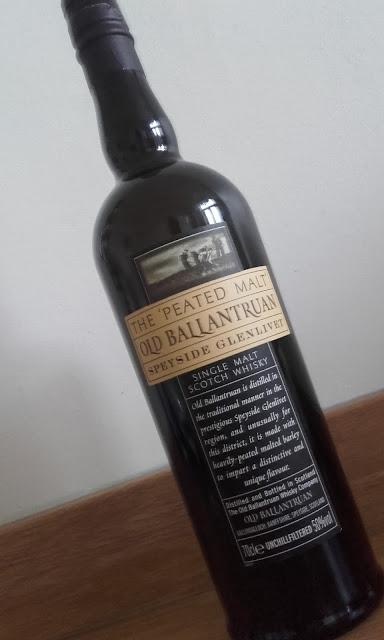I
embarked on a bit of an odyssey in selecting this purchase. I hope
you won’t find what follows boring, but it all forms part of the
narrative.
It had come to my attention that a re-stocking was long overdue,
though it’s not that I’ve been drinking more of late. You see, I
like to keep lots of things in stock, so when I start to approach the
bottom of a bottle, I have a tendancy to move on to something more
volumous. Inevitably this eventually leads to a situation where
nearly all your bottles are approaching their end, and you seem to be
finishing something every time you have a drink. So with pay day in
the very recent past, it was time to go shopping.
Before
reaching my decision I had to forego some very tempting offers at
Costco – a single cask Jack Daniels, because I’m saving potential
US whisky purchases for an upcoming visit to Duty Free; a Hakushu
because I wasn’t in the market for it; the Lapgroaig 10 that I’ve
wanted to revisit for pure time, because I have had it before and
Islay isn’t on my procurement matrix for a while yet; a Lagavulin
16 for the same reason; and a Tullibardine because I wasn’t looking
for a Highland malt. Because, yes, I had already determined that this
time around I was looking for a vintage Lowland malt.
Just
for the record, I also had to forego decent offers on various
Glenmorangies and Glenfiddichs in Sainburys because, if you let
yourself, you could easily end up buying these all time time as they
are in every supermarket, always on offer, and there always seems to
be a new expression – there was even a Midwinter Night’s Dram
from Glenmorangie, which struck me as odd on the hottest day of
the year at the end of May.
Anyway,
when it came to drawing up a shortlist it was all Auchentoshans and
Glenkinchies. I can’t say I was finding the prospect of them all
that exciting, but it’s all part of the whisky education and it
means I’ll’ve completed the Lowland region before too long.
So
the cheapest malt to consider was Auchentoshan’s Valinch 2012 at
£40.45 (at The Whisky Exchange). I didn’t want to go that cheap,
though it is worth mentioning that this was selling at £60 at Master
of Malt and a massive £70 at Amazon. Then you had various
Glenkinchie distillery editions, dated between 1996 and 2003 and all
retailing from £48.95 to £55.95 (all prices exclusive of P&P
btw). I wasn’t drawn to these because, despite looking the part,
they’ve all been finished in sherry casks, and I’m a bit tired of
that.
What
it boiled down to then, was a choice between three or four merchant
bottlings of Auchentoshan – each blended from two casks. I couldn’t
find any indication as to which of these bottlings might be the best
to get, so I just took a decision based on economics, having compared
prices across a number of suppliers.Just within, but veering towards,
the outside of my price range was an 18 year old Signatory from 1997.
That was just under £80. When I saw a (more or less) identical 1998
17 year old though, at just under £60, I figured that seemed like
better value for money. Finally though, I made one last compromise
because I found the 1999 15 year old at just under £50. That would
leave a bit of cash to get some tequila too.
In
terms of the Lowland region, most of my experience has been with the
now defunct Bladnoch distillery. You might remember I was
delighted by a ten year old, and disappointed with a cask strength 12
year old. Other than that, I have tried a single glass of the
standard Auchentoshan once before. I remember not being impressed,
but that’s the way it goes sometimes – it was a single glass so
there’s really no way of knowing what I really thought of it.
Auchentoshan
triple distils all its whisky, and this sets them apart from
all other Scottish distilleries. Signatory, on the other hand, is an
independent bottler supplying three types of product – 86 proof,
cask strength and un-chillfiltered (this one belongs to the latter
collection) – representing all of the distilling areas of Scotland.
The Cask Strength ones have a particularly intriguing bottle, but
this isn’t one of those. It’s a fairly standard bottle with a no
fuss label and gothic lettering, and it comes in a silvery
tin-cardboard hybrid tube. It is bottled at 46%.
It
is very pale in colour, and very light in body. I haven’t
really had anything as light bodied as this before, and while I tend
to prefer my whiskies full and oily, that isn’t a mark against the
Auchentoshan. It’s just different is all. The nose is a little
tangy, while on the tongue it almost feels like a gentle wash of wood
that’s going to float up from your tongue and evaporate.
It
has slipped out of the bottle and down my throat very easily, so
easily in fact that I don’t remember drinking so much of it. I must
be pouring larger measures.
Anyway,
it looks like I’ve only fully evaluated three merchant bottlings
previously, and this one is going into 2nd place behind
the Bunnahabhain 1979 and ahead of the Fettercairn 7
with Scapa 2001 bringing up the rear. As for comparisons with
the single malt genre in general… I’m struggling to place it.
Probably just outside the top 10 though.



